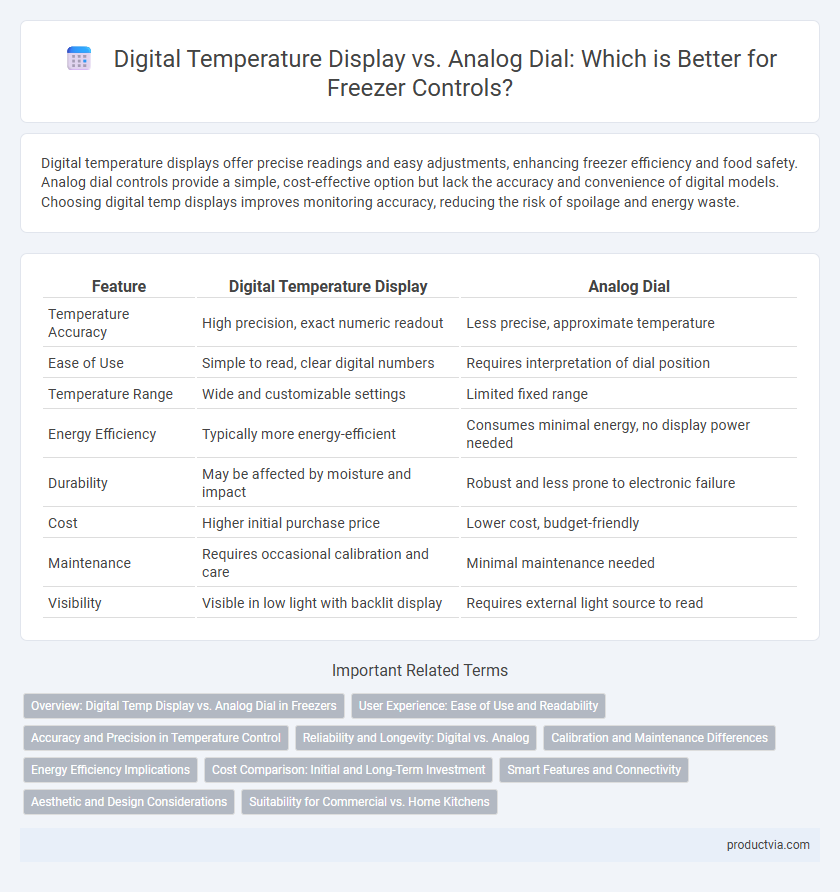Digital temperature displays offer precise readings and easy adjustments, enhancing freezer efficiency and food safety. Analog dial controls provide a simple, cost-effective option but lack the accuracy and convenience of digital models. Choosing digital temp displays improves monitoring accuracy, reducing the risk of spoilage and energy waste.
Table of Comparison
| Feature | Digital Temperature Display | Analog Dial |
|---|---|---|
| Temperature Accuracy | High precision, exact numeric readout | Less precise, approximate temperature |
| Ease of Use | Simple to read, clear digital numbers | Requires interpretation of dial position |
| Temperature Range | Wide and customizable settings | Limited fixed range |
| Energy Efficiency | Typically more energy-efficient | Consumes minimal energy, no display power needed |
| Durability | May be affected by moisture and impact | Robust and less prone to electronic failure |
| Cost | Higher initial purchase price | Lower cost, budget-friendly |
| Maintenance | Requires occasional calibration and care | Minimal maintenance needed |
| Visibility | Visible in low light with backlit display | Requires external light source to read |
Overview: Digital Temp Display vs. Analog Dial in Freezers
Digital temperature displays in freezers provide precise, real-time temperature readings and easier control adjustments, enhancing accuracy in food preservation. Analog dial controls offer simplicity and durability but lack exact temperature feedback, which can lead to inconsistent cooling. Choosing between digital and analog depends on user preference for precision versus traditional reliability in freezer management.
User Experience: Ease of Use and Readability
Digital temperature displays on freezers offer precise, easy-to-read temperature settings that enhance user experience by reducing guesswork and enabling quick adjustments. Analog dials may be less intuitive, requiring users to estimate temperature levels, which can lead to inconsistencies and potential food safety issues. Clear visibility and accurate readings with digital controls improve convenience and ensure optimal freezer performance.
Accuracy and Precision in Temperature Control
Digital temperature displays in freezer controls provide higher accuracy and precision compared to analog dials by showing exact temperature readings, typically within +-0.5degF. Analog dials rely on manual adjustments and visual estimation, which can lead to temperature fluctuations and less consistent preservation of frozen goods. Precise temperature control with digital displays helps maintain optimal food safety and energy efficiency in freezers.
Reliability and Longevity: Digital vs. Analog
Digital temperature displays for freezers offer precise and consistent readings, enhancing reliability by minimizing user error and providing accurate monitoring. Analog dial controls tend to have mechanical components that can wear out over time, potentially reducing long-term durability and requiring more frequent calibration or replacement. Digital systems generally have longer longevity due to solid-state technology and fewer moving parts, resulting in better performance and reduced maintenance over the freezer's lifespan.
Calibration and Maintenance Differences
Digital temp displays in freezers offer precise calibration through automated sensors and easy software adjustments, reducing human error and enhancing temperature accuracy. Analog dial controls rely on manual calibration, requiring regular maintenance to ensure the dial matches actual temperature readings, which can drift over time due to mechanical wear. Digital systems generally demand less maintenance and provide real-time alerts for calibration issues, whereas analog systems may require frequent physical inspections and recalibration to maintain optimal freezer performance.
Energy Efficiency Implications
Digital temperature displays offer precise control over freezer settings, enabling users to maintain optimal temperatures more consistently, which improves energy efficiency by reducing temperature fluctuations and overcooling. In contrast, analog dial controls can lead to less accurate temperature management, causing the freezer to work harder and consume more energy. Energy-efficient freezers with digital displays often incorporate advanced sensors and programmable settings that optimize cooling cycles and minimize power usage.
Cost Comparison: Initial and Long-Term Investment
Digital temperature displays for freezers generally have a higher initial cost due to advanced technology and features but offer greater precision and easier temperature monitoring. Analog dial controls tend to be less expensive upfront, with simpler mechanics and lower repair costs, making them a budget-friendly choice for short-term use. Over the long term, digital controls can reduce energy expenses and improve food preservation, potentially offsetting higher upfront costs through efficiency and reliability.
Smart Features and Connectivity
Digital temp displays in freezers offer precise temperature readings and integrate smart features like Wi-Fi connectivity for remote monitoring and control via smartphone apps. Analog dials lack real-time alerts and remote access, limiting user convenience and responsiveness to temperature fluctuations. Smart digital controls enhance energy efficiency by allowing users to adjust settings instantly and receive notifications for optimal freezer management.
Aesthetic and Design Considerations
Digital temp displays on freezers offer sleek, modern aesthetics with clear, precise readouts that enhance user experience and complement contemporary kitchen designs. Analog dial controls provide a classic, tactile feel with a vintage charm but may lack the visual precision and seamless integration found in digital panels. Choosing between digital and analog often depends on the desired design style, user interface preference, and overall freezer aesthetic.
Suitability for Commercial vs. Home Kitchens
Digital temperature displays offer precise and easily readable control ideal for commercial kitchens where accuracy and quick monitoring are critical for food safety compliance. Analog dial controls, while less exact, provide simplicity and durability favored in home kitchens where ease of use and cost-effectiveness take precedence. Commercial environments benefit from the advanced features of digital displays, including alerts and data logging, whereas home users often prefer the straightforward functionality of analog dials.
Digital Temp Display vs Analog Dial for Freezer Controls Infographic

 productvia.com
productvia.com